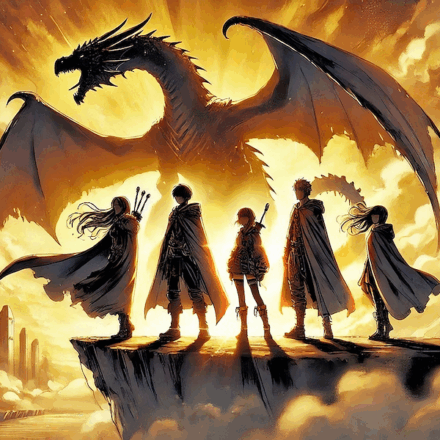Today’s guest article by Gnome Stew reader Craig Dedrick explores villains’ plans that stay in motion while the PCs are doing other things. Thanks, Craig! –Martin
What’s He Building?
He has no dog
And he has no friends and
His lawn is dying… and
What about all those packages
He sends. What’s he building in there?
With that hook light
On the stairs. What’s he building
In there… I’ll tell you one thing
He’s not building a playhouse for
The children what’s he building
In there?
— Tom Waits
Inspired by the recent Gnome Stew articles Session Organization: Breadcrumbs by John Fredericks, and Aaron Ryyle’s Using Backwards Design in Game Prep, I have decided to share another method of preparation that works well with both of these tools. In a nutshell, I challenge myself to answer the question, “What are the bad guys up to when the PCs aren’t watching?”
Your NPCs are important figures in your game world. You might have Kings of neighbouring nations, important nobles, ambitious arch-villains, or leaders of different occult organizations. What do they want, and how will they achieve it? What is that crazy neighbour building in his basement? Crafting well thought-out NPCs and thinking about their motivations will give you plenty of fodder for “breadcrumbs” from one session to the next. Like many players, Tom Waits was irresistibly curious about what his neighbour was doing. He knew that he was up to something unusual, but he could not see it. The machinations of a mysterious NPC will be irresistible to curious PCs, and serve as an effective adventure hook.
Step One: What is the story?
When you being the process of story building, if you use the backwards design approach, you will think about where you want the story to go. Part of that process is to think about the major figures in that story. Who are the antagonists? Who are the potential allies? For example, I have come up with an idea for a low-level D&D campaign in which the PCs are in a low magic world, but there is another plane full of very powerful races. These races wish to enter this world and exploit it. I know that my major story beats will involve the PCs finding out about this other world, having a portal open to it, and having the PCs try to subsequently close the portal and defeat the powerful forces from the other side. Now I have a question to answer: who wants this portal open, and why?
Step Two: Who are my major NPCs?
Now that I know the beats of my story, I need a few characters to help drive the action forward.
- Mordight: an advisor to the king who has discovered a means of opening the portal. He thinks that he can gain power from the other plane, and seeks to open the portal for his own gains.
- Hektor: a rival advisor to the King, and a secret member of the Cult of Rhut val Tuun, an organization that seeks to open a portal to the other plane in order to allow the minions of their dark god to enter this world.
- King Welran: if I have advisors, then I need a King. This is the young King of the most powerful nation. He is mostly interested in having a good time and is easily manipulated by his advisors.
- Lord Marcel: a nobleman who believes that King Welran is a corrupt fool, and is secretly preparing an army to rebel against him for the good of the nation.
These simple, one-sentence descriptions of the major characters in play will serve as the launching pad for the campaign.
Step Three: What are the NPC’s doing?
Now that I know who my NPCs are, and what their goals are, I can think about how they are going to accomplish these goals.
- Mordight: this character obviously wants to open the portal. In order to do that, he needs to find out where it is and how to open it. He needs to hire an adventuring company to investigate the tomb of a long-dead wizard who was an expert on the subject.
- Hektor: this character also wants to know how to open the portal. He is spying on Mordight in order to try and find out what he knows about it.
- Lord Marcel: he is not interested in the portal at all, but he is recruiting allies for his secret army that he will use to overthrow the King. Marcel has agents travelling the country to find skilled warriors and adventurers who are sympathetic to his cause.
- King Welran: he just wants to have fun. He is throwing a big party to celebrate his birthday.
Step Four: How do the NPC motivations shape the session?
Looking at what I have so far, I decide to set the first session at a party thrown by King Welran. The PCs will be guests or security, depending on the type of party I am working with. Now I can drill down further into the actions of each of my big NPCs at this party, moving from story level motivations to session level motivations.
- Mordight: he wants to hire an adventuring company to explore the tomb. There are multiple adventuring companies at the party. He will approach the PCs first, and if they turn him down, he will approach a rival group.
- Hektor: he has a spy or two at the party to watch what Mordight is up to. If Mordight hires a group to raid the wizard’s tomb, Hektor will try to hire a rival group to get there first.
- Lord Marcel: he has an ally at the party (a bard?) who is keeping an eye out for adventurers who will be sympathetic to his cause and approach them.
- King Welran: he will party like it’s 1999! The PC’s will witness his excess, contrasted with some of the poverty seen around town, and they will be invited to join in the frivolity. PCs will form an opinion of the King here —- either they will have a good time partying with him, and he will consider them allies, or they will be repulsed by his extravagance while his people suffer.
Step Five: Leads for the PCs.
Now that we have established how the NPCs’ goals will influence the session, we can use the bullet point method to generate some leads and create some incidents that may happen at the party.
- PCs will see evidence of poverty in the city en route to the extravagant party at the castle.
- A PC meets a castle librarian who can mention that Mordight has been researching an ancient wizard for some time. He does not know why Mordight is interested in this wizard, but more information is available at the library if the PC’s want to do some research.
- Mordight approaches the PCs with a job to raid the tomb of a long-dead wizard.
- The PCs overhear one of the entertainers (Marcel’s bard) talking with an adventurer about attending a secret meeting later that night.
- The PCs observe a shadowy figure (one of Hektor’s spies) eavesdropping on a conversation between Mordight and another adventuring group.
- Hektor approaches the PCs, or a rival group, about raiding the tomb before Mordight’s group. He will lie and claim that Mordight is up to no good, and that he must be stopped.
- King Welran challenges several members at the party, including one or more PCs, to a drinking contest. If the PC plays along, he will be rewarded with drinks, courtesans and riches.
- King Welran mocks and ridicules one of the servants.
- Mordight influences the King to bestow gifts upon whichever adventuring group has decided to accept his mission.
Many of these incidents are optional, and could happen at any time. You have the opportunity to introduce a rival group of adventurers as well as some minor NPCs. If the PCs pick up one of these leads at the party and run with it, you have a good idea of the type of information that they can discover and where it will lead to. The PCs will have the sense that things are happening in the world around them, and they have choices regarding which leads to follow. Will they be working for Mordight, or Hektor, or against them both? Do they interrogate Hektor’s spy, or follow him? Do they attend Marcel’s secret meeting, spy on it, or ignore it? Do they have a good time with the King, or will they find his behaviour to be despicable? They have many options, and because you know what is motivating the big NPCs, you can let the PCs be free to explore the sandbox.
How do you use NPC motivations to influence a campaign or a session?

















Hey, thanks for the shout-out! This is a great article with plenty of food for thought. I have found that sometimes one needs to know what the NPCs are building to make any sense of a session at all. For example, in an intrigue game, the GM needs to know what moves the antagonist is making to figure out the sequence of encounters. In a game focused on war, the GM needs to know troop locations and ultimate objectives. As you point out, this can help the GM scatter his or her breadcrumbs; it also helps for improvising when players go off in an unexpected direction.
Thanks Ryan! I find this approach to be very useful for those times when the players go off-book, or when they propose something to an NPC that is completely out of left-field. If the NPCs have been tied to PC backgrounds, it works even better!
This is solid advice. When you play Dogs in the Vineyard, you start play with essentially the information listed through step 3: you know your NPCs, what they want, and have an idea of what they’re willing to do to get it. The game structure (the Dogs are somewhat like supernatural police) builds in a formula for taking steps 1-3 and developing steps 4 & 5.
I enjoy the ferreting out of the twisted motivations, and like the setup of the adventurers acquiring magics that are going to be abused by their employer…
Thanks Scott. I find that if the PCs are somehow responsible for a calamity, then they have an even greater motivation to find a solution.
I’ve never tried Dogs in the Vineyard, but I have read good things about it. I will have to give it a try!